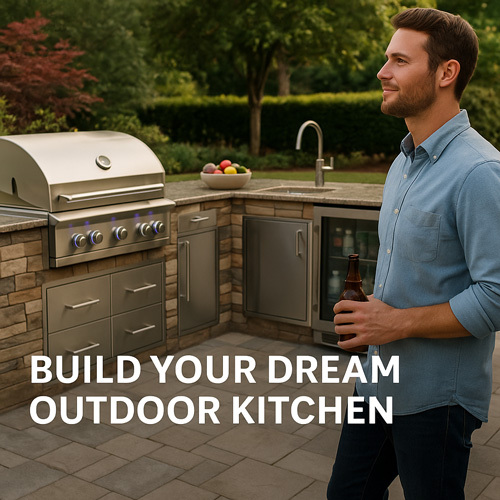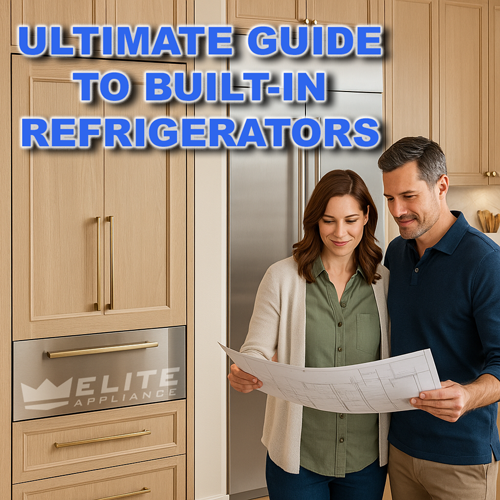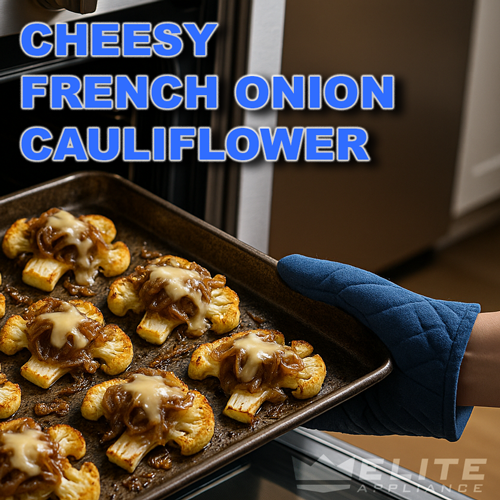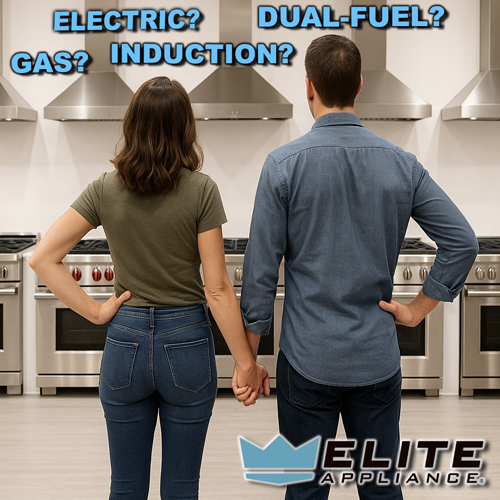How to Choose the Right Luxury Range for Your Cooking Style
Investing in a luxury kitchen range is more than just a purchase—it’s a reflection of your cooking style and your kitchen’s personality. At Elite Appliance, we know every home chef has different needs. That’s why we help our customers pair the perfect range with the way they cook, entertain, and live.
From gourmet meal preppers to busy families, here’s how to choose the right range for your lifestyle.
Start with Your Cooking Personality
Ask yourself:
- Are you the experimental home chef who loves to play with flavors?
- Do you entertain often and cook for a crowd?
- Is baking your passion?
- Or do you just need speed, convenience, and reliability every weeknight?
Once you know your style, the right appliance becomes a lot easier to find.
 From gas, electric, induction & dual-fuel, so many choices.
From gas, electric, induction & dual-fuel, so many choices.
Gas, Electric, Induction, or Dual-Fuel: What’s Right for You?
The cooktop and oven type matter just as much as the brand or finish. Here’s a breakdown:
Gas Ranges – For Flame Control & Speed
Gas offers instant heat adjustment with visible flame control—perfect for sautéing, simmering, and searing.
Best for: Traditionalists, skilled home chefs, and entertainers.
Gas ranges have long been the top choice for chefs and passionate home cooks—and with good reason. One of the biggest advantages of gas cooking is the immediate and visible heat control it provides. Unlike electric or induction cooktops, which rely on internal sensors and digital controls, gas burners respond instantly. You can see the flame size change as you adjust the dial, giving you precise, intuitive control over cooking temperatures. This is especially valuable for techniques like simmering sauces, searing meat, or stir-frying, where timing and temperature can make or break a dish.
Another significant benefit is the versatility of cooking styles that a gas range supports. You can char vegetables directly over the flame, tilt pans for flambéing, or use specialty cookware like woks or cast iron with confidence—none of which work quite the same on flat glass or induction surfaces. For many homeowners, a gas range also provides peace of mind during power outages, as it can continue to function (often with manual ignition), while electric and induction cooktops go offline.
In terms of durability and repair, gas ranges often outlast their high-tech counterparts. With fewer digital components, they're generally easier to service, and replacement parts like igniters or burners are more straightforward to source and install. For those looking for long-term value, many find gas ranges offer lower operating costs, as natural gas tends to be less expensive than electricity in many areas.
While electric and induction ranges have their own strengths—such as easy cleaning or ultra-modern features—gas remains a go-to for serious cooks who want reliability, power, and flexibility at their fingertips.
Not so Greats: As ranges can be harder to clean due to open burners and grates, and they often lack the precise oven temperature control that electric or induction ovens provide. Additionally, they require a gas hookup, which may not be available or safe in all homes.
Electric Ranges – For Even Baking & Easy Cleanup
With smooth cooktops and steady heat, electric ranges are ideal for consistent oven performance, especially great for baking.
Best for: Passionate bakers and easy-clean fans.
Electric ranges are a favorite among home bakers and everyday cooks who value consistent, even heating and simplicity. Unlike gas burners that can produce uneven hot spots, electric cooktops provide stable and uniform surface heat, making them ideal for slow simmering, boiling, and sautéing. Electric ovens also tend to hold temperature more evenly than gas ovens, offering reliable baking performance—an essential for anyone who enjoys cakes, cookies, or roasted dishes. Plus, smooth-top electric models add a sleek, modern appearance to your kitchen and double as extra counter space when not in use.
Electric ranges are also generally more affordable upfront and easier to install, especially in homes that don’t already have a gas line. They’re low-maintenance, with fewer components to clean or repair than gas ranges, and they don’t require special cookware like induction models do. While they may take slightly longer to heat up than gas or induction, many homeowners find electric ranges offer a dependable, low-fuss solution that’s perfect for everyday family meals and traditional kitchen setups.
Not so greats: Electric ranges tend to heat up and cool down more slowly than gas or induction, making precise temperature adjustments harder during cooking. Additionally, the smooth glass cooktops can be prone to scratching or cracking if heavy cookware is dropped or dragged across the surface.
Induction Ranges – For Modern Speed & Safety
Induction cooktops heat cookware directly using magnetic energy. They’re incredibly fast, energy-efficient, and safe (cooktops stay cool to the touch).
Best for: Tech lovers, families with kids, and modern cooks seeking clean design.
Induction ranges offer a cutting-edge cooking experience that combines speed, safety, and precision. Unlike traditional electric or gas cooktops, induction heats cookware directly using electromagnetic energy—meaning your pan gets hot, but the cooktop itself stays cool. This results in incredibly fast boil times, instant temperature changes, and less wasted heat in the kitchen. It’s ideal for families or multitaskers who want the responsiveness of gas with the clean, sleek look of electric. Plus, since the surface remains cool to the touch, it's significantly safer for households with kids or pets.
In addition to speed and control, induction cooktops are incredibly easy to clean. Because spills don’t burn onto a hot surface, you can simply wipe them away after cooking. Induction also offers impressive energy efficiency—it transfers heat directly to the cookware with minimal loss, making it more eco-friendly than gas or traditional electric. While it does require compatible cookware (magnetic stainless steel or cast iron), many homeowners find that the trade-off is well worth it for the ultra-modern functionality, sleek appearance, and professional-level performance induction provides.
Not so greats: While induction ranges are fast and energy-efficient, they require compatible cookware* and can be more expensive upfront than traditional gas or electric models.
* Note: You’ll need magnetic cookware—like cast iron or select stainless steel.
Dual-Fuel Ranges – The Best of Both Worlds
Combining gas burners with an electric oven, dual-fuel ranges offer fast cooktop performance with precision baking.
Best for: Serious cooks who demand versatility.
Dual-fuel ranges are considered the gold standard for serious home cooks because they combine the best of both cooking worlds: a gas cooktop for powerful, responsive flame control and an electric oven for precise, even baking. The gas burners give you the tactile feel and immediate heat adjustment preferred for stovetop tasks like searing, sautéing, or boiling. Meanwhile, the electric oven ensures accurate temperature regulation and even heat distribution, which is ideal for baking delicate pastries, roasting meats, or preparing multi-layer casseroles. This hybrid setup makes dual-fuel ranges incredibly versatile and a favorite in professional-style kitchens.
What sets dual-fuel apart from other range types is its ability to excel in both speed and accuracy, delivering performance that neither gas nor electric can fully achieve on their own. While dual-fuel ranges often come at a higher price point and may require both gas and 240V electric connections, the cooking benefits far outweigh the added complexity for many high-end homeowners. They’re perfect for those who want professional-level performance, flexibility, and premium features packed into one appliance.
Not so greats: Dual-fuel ranges tend to be more expensive and require both gas and electric hookups, which may involve additional installation costs.
What Size Range Do You Need?
- 30" – Ideal for most homes and smaller kitchens
- 36" or 48" – Great for avid cooks or entertainers needing more burners or oven space
- 60"+ – Top-tier models for pro chefs or custom kitchens
* Some ultra high-end homeowners even install two separate ranges—or combine a large range with a wall oven—to create custom cooking zones that go far beyond what any single range can offer.
* Let our showroom team help you measure your space and match ventilation needs.
Why Some Chefs Install Two Ranges in One Kitchen
In ultra-premium kitchens—especially among serious home chefs and culinary enthusiasts—it's not uncommon to find two separate ranges installed side by side or in different zones of the kitchen. Why? Because no single range can offer every cooking advantage. By combining two different types or sizes of ranges, chefs create a custom setup tailored to their unique cooking routines.
For example, a chef might install a 36" dual-fuel range for everyday meals—taking advantage of the gas cooktop and electric convection oven—alongside a 36" all-induction range for ultra-fast boiling, precise simmering, or cleanup efficiency. Others may pair a gas range for wok cooking and flame roasting with a fully electric oven for delicate baking tasks. Some high-end households even opt for a larger range for family meals and a smaller range or cooktop for entertaining or prep overflow.
This dual-range strategy offers unmatched flexibility, redundancy, and power. It allows cooks to run multiple complex recipes at once, use different oven temperatures simultaneously, or separate meal prep by cooking method or dietary preference. In luxury kitchens where space and investment aren’t barriers, installing two ranges is the ultimate way to unlock complete culinary freedom.
Features to Look For in a Luxury Range
- High-BTU power burners (18,000–22,000 BTU)
- Precision simmer and rapid-boil zones
- True convection ovens
- Built-in griddles, steam ovens, or warming drawers
- Smart features: Wi-Fi control, auto-clean, touchscreens
Ask us for a live demo or a side-by-side comparison of top features by brand.
Elite Appliance’s Most Popular Range Brands
- Wolf – Known for durability, pro-grade performance, and signature red knobs
- Miele – Sleek, German-engineered dual-fuel options with intuitive controls
- BlueStar – Custom-built, commercial-quality ranges with open burners, unmatched power, and more than 1,000 color and trim combinations
- JennAir – Bold design with cutting-edge innovation
- Viking – Rugged, American-made, and restaurant-inspired
Let Us Help You Find the Perfect Fit
Choosing the right luxury range comes down to understanding your cooking habits, kitchen layout, and performance preferences. Whether you prefer the precision of induction, the power of gas, or the versatility of dual-fuel, there’s a perfect fit for every lifestyle. At Elite Appliance, our expert team is here to guide you through the options and help you find a range that not only meets your needs but also elevates your entire kitchen experience. A luxury range is the heart of your kitchen—make sure it fits your lifestyle, layout, and cooking goals. Whether you shop online or visit our Dallas showroom, the expert sales team at Elite Appliance is here to help.
• Visit our luxury only showroom at: 4901 Alpha Rd, Dallas, TX (Just across the Dallas North Tollway from the Galleria Dallas)
• Call us: 214‑306‑6900
• Shop Luxury Ranges Online
Here's a handy chart comparing gas, electric, induction, and dual-fuel ranges.
 Side-by-side visual comparison chart summarizing the strengths and limitations of Gas, Electric, Induction, and Dual-Fuel ranges
Side-by-side visual comparison chart summarizing the strengths and limitations of Gas, Electric, Induction, and Dual-Fuel ranges





